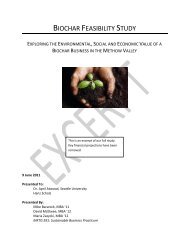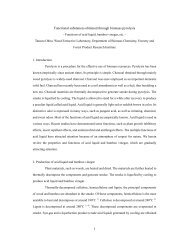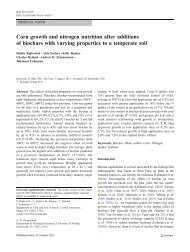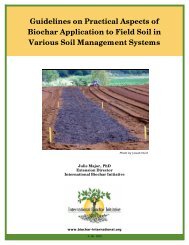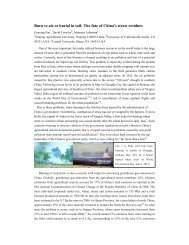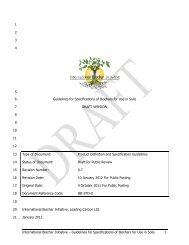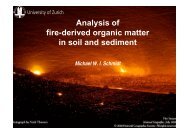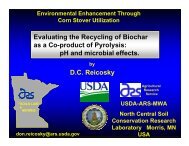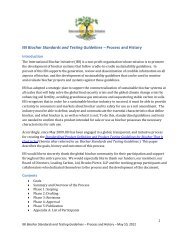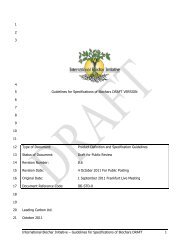Guidelines for the Development and Testing of Pyrolysis Plants to ...
Guidelines for the Development and Testing of Pyrolysis Plants to ...
Guidelines for the Development and Testing of Pyrolysis Plants to ...
Create successful ePaper yourself
Turn your PDF publications into a flip-book with our unique Google optimized e-Paper software.
<strong>Guidelines</strong> <strong>for</strong> <strong>the</strong> <strong>Development</strong><br />
<strong>and</strong> <strong>Testing</strong> <strong>of</strong> <strong>Pyrolysis</strong> <strong>Plants</strong><br />
<strong>to</strong> Produce Biochar<br />
Jane Lynch<br />
Technology Extension Direc<strong>to</strong>r<br />
International Biochar Initiative<br />
Stephen Joseph<br />
Technical Direc<strong>to</strong>r<br />
International Biochar Initiative<br />
www.biochar-international.org<br />
© IBI, 2010
Acknowledgements: The authors would like <strong>to</strong> thank Cordner Peacocke, Robert<br />
Brown <strong>and</strong> KC Das <strong>for</strong> reviewing <strong>and</strong> commenting on this material.<br />
Disclaimer: This document has been produced as a guideline <strong>to</strong> provide advice on equipment design<br />
<strong>and</strong> testing <strong>and</strong> biochar application. It is not an exhaustive guideline <strong>and</strong> does not provide<br />
comprehensive evaluation <strong>of</strong> <strong>the</strong> potential hazards possible in <strong>the</strong> design <strong>and</strong> testing <strong>of</strong> pyrolysis<br />
plants. The International Biochar Initiative accepts no responsibility <strong>and</strong> recommends <strong>the</strong> use <strong>of</strong><br />
pr<strong>of</strong>essional engineers <strong>for</strong> proper system design.<br />
Document Version In<strong>for</strong>mation:<br />
Ver. 1.1, 7 June 2010
Table <strong>of</strong> Contents<br />
1. INTRODUCTION ..................................................................................5<br />
1.1. Components <strong>of</strong> <strong>Pyrolysis</strong> <strong>Plants</strong> ........................................................5<br />
2. THE DESIGN PHASE – SAFE, EFFICIENT, APPROPRIATE ............................6<br />
2.1. Sound Engineering Design Practice ...................................................6<br />
2.1.1. Functional Specification .............................................................6<br />
2.1.2. Develop a Process Flow Diagram <strong>and</strong> Mass <strong>and</strong> Energy Balances .....9<br />
2.1.3. Process <strong>and</strong> Instrumentation Diagram (PID)...............................12<br />
2.1.4. HAZOP Methodology ...............................................................12<br />
2.1.5. Detailed Design <strong>and</strong> Costing.....................................................14<br />
2.1.6. Design Review .......................................................................14<br />
2.1.7. Documentation.......................................................................14<br />
2.2. Design Checklists .........................................................................14<br />
2.2.1. Health <strong>and</strong> Safety Considerations..............................................14<br />
2.2.2. Environmental Considerations ..................................................15<br />
2.2.3. Technical Considerations .........................................................15<br />
2.2.4. Economic Considerations .........................................................16<br />
2.2.5. Training <strong>and</strong> Staffing...............................................................16<br />
3. THE SETUP PHASE - BEFORE TESTING STARTS......................................17<br />
3.1. Test Location...............................................................................17<br />
3.2. Occupational Health <strong>and</strong> Safety......................................................17<br />
3.3. S<strong>to</strong>rage <strong>and</strong> H<strong>and</strong>ling <strong>of</strong> Feeds<strong>to</strong>ck <strong>and</strong> Biochar................................18<br />
3.4. Preparation <strong>of</strong> Equipment Required <strong>for</strong> <strong>Testing</strong> .................................18<br />
4. TESTING THE PLANT - WHAT DO WE WANT TO KNOW? ..........................18<br />
4.1. Optimal Feeds<strong>to</strong>ck Characteristics ..................................................18<br />
4.2. Operating Procedures that Produce Desired Product Characteristics.....19<br />
4.3. Biochar Produced .........................................................................19<br />
4.4. Gas Produced ..............................................................................20<br />
5. OPERATING THE PLANT SAFELY AND EFFICIENTLY .................................20<br />
5.1. Feeds<strong>to</strong>ck Preparation, S<strong>to</strong>rage, H<strong>and</strong>ling <strong>and</strong> Loading ......................20<br />
5.2. Start-up <strong>and</strong> Shut-down ...............................................................20<br />
<strong>Guidelines</strong> <strong>for</strong> <strong>Pyrolysis</strong> <strong>Plants</strong>—International Biochar Initiative Page 3
5.3. Operation <strong>and</strong> Moni<strong>to</strong>ring ..............................................................21<br />
5.4. Unloading, S<strong>to</strong>rage <strong>and</strong> H<strong>and</strong>ling <strong>of</strong> Biochar.....................................21<br />
5.5. Maintenance................................................................................22<br />
6. DATA COLLECTION ............................................................................22<br />
6.1. Measurement Equipment Required .................................................22<br />
6.2. Data Collection: Inputs .................................................................23<br />
6.3. Running <strong>the</strong> Equipment: Conditions <strong>and</strong> variables............................23<br />
6.4. Data Collection: Outputs ...............................................................23<br />
6.5. Quality Control ............................................................................24<br />
6.5.1. Eco-<strong>to</strong>xicity <strong>Testing</strong> ................................................................25<br />
6.5.2. Germination <strong>Testing</strong>................................................................25<br />
6.5.3. Adsorption <strong>and</strong> Cation Exchange Capacity <strong>Testing</strong> .......................25<br />
6.5.4. Agronomic <strong>Testing</strong> ..................................................................25<br />
6.5.5. Field Trials.............................................................................27<br />
6.6. Data Analysis ..............................................................................27<br />
7. APPENDICES.....................................................................................27<br />
APPENDIX A:EXAMPLES OF ENVIRONMENTAL PROTECTION LEGISLATION.......27<br />
APPENDIX B: GASIFIER TESTING ..............................................................28<br />
APPENDIX C: BASIC DATA ANALYSIS.........................................................28<br />
APPENDIX D: PROCESS INSTRUMENTATION DIAGRAM.................................30<br />
REFERENCES..........................................................................................30<br />
Page 4<br />
<strong>Guidelines</strong> <strong>for</strong> <strong>Pyrolysis</strong> <strong>Plants</strong>—International Biochar Initiative
1. INTRODUCTION<br />
This document was produced <strong>to</strong> assist in <strong>the</strong> development <strong>and</strong> testing <strong>of</strong> small pyrolysis<br />
plants <strong>and</strong> provides advice on equipment design <strong>and</strong> testing as well as <strong>the</strong> specification<br />
<strong>and</strong> testing <strong>of</strong> <strong>the</strong> biochar product.<br />
The International Biochar Initiative encourages innovation <strong>and</strong> development <strong>of</strong> biochar<br />
production technologies at all scales. Because <strong>the</strong>re are personal <strong>and</strong> environmental health<br />
<strong>and</strong> safety risks inherent in producing biochar, IBI has developed <strong>the</strong>se <strong>Guidelines</strong> <strong>to</strong> assist<br />
in <strong>the</strong> safe <strong>and</strong> effective development <strong>and</strong> testing <strong>of</strong> biochar production technologies. The<br />
<strong>to</strong>p concerns are <strong>to</strong>:<br />
<br />
<br />
<br />
Ensure <strong>the</strong> safety <strong>of</strong> equipment opera<strong>to</strong>rs <strong>and</strong> <strong>the</strong> general public<br />
Minimise emissions <strong>of</strong> atmospheric contaminants<br />
Produce biochar that is suitable <strong>for</strong> soil application (refer <strong>to</strong> documentation <strong>of</strong><br />
International Biochar Initiative’s Characterisation Workgroup <strong>for</strong> parameters).<br />
IBI seeks <strong>to</strong> promote biochar <strong>for</strong> environmental management <strong>and</strong> biochar production<br />
methods which are safe <strong>and</strong> beneficial <strong>for</strong> people <strong>and</strong> <strong>the</strong> environment. You can find more<br />
in<strong>for</strong>mation about <strong>the</strong> IBI <strong>and</strong> about biochar at <strong>the</strong> IBI website:<br />
www.biochar-international.org<br />
1.1 Components <strong>of</strong> <strong>Pyrolysis</strong> <strong>Plants</strong><br />
<strong>Pyrolysis</strong> is <strong>the</strong> <strong>the</strong>rmal degradation <strong>of</strong> biomass under <strong>the</strong> absence <strong>of</strong> oxygen. <strong>Pyrolysis</strong><br />
results in three products: biochar, non-condensable gases <strong>and</strong> condensate (tars <strong>and</strong><br />
water). The proportion <strong>of</strong> each is a strong function <strong>of</strong> <strong>the</strong> feeds<strong>to</strong>ck <strong>and</strong> <strong>the</strong> operating<br />
conditions <strong>of</strong> <strong>the</strong> pyrolyser. Some systems (slow pyrolysers) focus on biochar production<br />
with syngas as <strong>the</strong> major co-product, while o<strong>the</strong>r systems (fast pyrolysers) focus on bio-oil<br />
(condensate) production with biochar as <strong>the</strong> major co-product. These guidelines focus on<br />
slow pyrolysers.<br />
Depending on <strong>the</strong> size <strong>and</strong> complexity <strong>of</strong> <strong>the</strong> pyrolysis plant, <strong>the</strong> main components <strong>of</strong> a<br />
pyrolysis plants include: pre-processing equipment (e.g. grinding, drying, chipping, sieves<br />
or screens), materials h<strong>and</strong>ling (belt conveyors, s<strong>to</strong>rage bins) <strong>and</strong> feeding equipment (feed<br />
screws, lock hoppers, feed belts), dryer (as required), biochar kiln, burners including<br />
syngas burners, gas cleaning, cooling <strong>and</strong>/or quenching equipment, instrumentation, <strong>and</strong><br />
electrical equipment including genera<strong>to</strong>rs.<br />
The outline <strong>of</strong> a Functional Specification <strong>for</strong> <strong>Pyrolysis</strong> Plant in 2.1.1.1 provides an example<br />
<strong>of</strong> <strong>the</strong> scope <strong>of</strong> components which may be part <strong>of</strong> a plant. The Process Flow Diagram in 2.2<br />
<strong>and</strong> <strong>the</strong> Process <strong>and</strong> Instrumentation Diagram in 2.4 provide illustrations <strong>of</strong> different<br />
pyrolysis plants.<br />
<strong>Guidelines</strong> <strong>for</strong> <strong>Pyrolysis</strong> <strong>Plants</strong>—International Biochar Initiative Page 5
2. THE DESIGN PHASE – SAFE, EFFICIENT,<br />
APPROPRIATE<br />
Good quality biochar manufactured safely <strong>and</strong> efficiently starts with good equipment<br />
design.<br />
The biochar community is growing every day. There are people <strong>and</strong> resources available <strong>to</strong><br />
assist with <strong>the</strong> design process. O<strong>the</strong>rs may have experienced similar design issues <strong>and</strong> be<br />
able <strong>to</strong> share commonly experienced pitfalls, problems <strong>and</strong> solutions. The potential<br />
designer <strong>of</strong> a plant should be acutely aware that <strong>the</strong>re is a range <strong>of</strong> pyrolysis companies<br />
operating world-wide, with a variety <strong>of</strong> experience <strong>and</strong> technologies. As much use as<br />
possible should be made <strong>of</strong> prior projects, in<strong>for</strong>mation <strong>and</strong> publications be<strong>for</strong>e starting a<br />
design.<br />
A good place <strong>to</strong> start connecting <strong>to</strong> o<strong>the</strong>rs interested in development <strong>of</strong> biochar<br />
technologies is through internet groups such as:<br />
http://tech.groups.yahoo.com/group/biochar-production/<br />
Using <strong>the</strong> following guidelines on sound engineering design practice will greatly assist in<br />
<strong>the</strong> development <strong>of</strong> safe, efficient <strong>and</strong> appropriate pyrolysis plants.<br />
2.1 Sound Engineering Design Practice<br />
The design process involves <strong>the</strong> following main steps that will result in a series <strong>of</strong><br />
documents that <strong>to</strong>ge<strong>the</strong>r constitute <strong>the</strong> complete design including design review <strong>and</strong><br />
documentation:<br />
<br />
<br />
<br />
<br />
<br />
<br />
<br />
Functional Specifications <strong>for</strong> <strong>the</strong> pyrolysis plant <strong>and</strong> <strong>the</strong> biochar product<br />
Process Flow Diagram<br />
Process Instrumentation Diagram<br />
HAZOP ( Hazard <strong>and</strong> Operability Study)<br />
Detailed Design <strong>and</strong> Costing<br />
Design Review<br />
Documentation<br />
2.1.1 Functional Specifications<br />
A Functional Specification is <strong>the</strong> documentation that describes <strong>the</strong> requested behaviour <strong>of</strong><br />
an engineered system. The documentation typically describes what is needed by <strong>the</strong><br />
system user as well as requested properties <strong>of</strong> inputs <strong>and</strong> outputs. It should be a coherent<br />
document, which allows <strong>the</strong> reader <strong>to</strong> appreciate how <strong>the</strong> entire process works <strong>and</strong> how it<br />
is integrated (if appropriate) <strong>and</strong> which demonstrates what each major unit operation does<br />
<strong>and</strong> how <strong>the</strong> material flows from <strong>the</strong> start <strong>to</strong> <strong>the</strong> end. In this case we need <strong>to</strong> develop<br />
Page 6<br />
<strong>Guidelines</strong> <strong>for</strong> <strong>Pyrolysis</strong> <strong>Plants</strong>—International Biochar Initiative
Functional Specifications <strong>for</strong> both <strong>the</strong> plant <strong>and</strong> <strong>the</strong> biochar product itself.<br />
2.1.1.1 Functional Specification <strong>for</strong> <strong>Pyrolysis</strong> Plant<br />
The table <strong>of</strong> contents <strong>of</strong> a functional specification could include <strong>the</strong> following:<br />
1. Introduction<br />
This defines <strong>the</strong> general philosophy behind <strong>the</strong> overall process, <strong>the</strong><br />
objectives <strong>of</strong> plant per<strong>for</strong>mance <strong>and</strong> product quality <strong>the</strong> plant must reach<br />
<strong>and</strong> <strong>the</strong> st<strong>and</strong>ards that will be used in <strong>the</strong> design <strong>of</strong> <strong>the</strong> plant. Separate<br />
functional specifications, in <strong>the</strong> <strong>for</strong>m <strong>of</strong> specification sheets will elaborate in<br />
more detail <strong>the</strong> functions <strong>of</strong> <strong>the</strong> unit operations that comprise <strong>the</strong> overall<br />
process. This allows <strong>the</strong> designer, or design team <strong>to</strong> focus on issues<br />
particular <strong>to</strong> each unit operation. A process flow diagram with all major<br />
process streams should be drafted at this time.<br />
2. Process Description<br />
This may be a simple description or a more detailed analysis <strong>of</strong> all <strong>of</strong> <strong>the</strong><br />
flows <strong>of</strong> materials <strong>and</strong> energy through <strong>the</strong> plant (<strong>for</strong> more details see Section<br />
2.1.2). The process description is essential <strong>for</strong> environmental permitting <strong>and</strong><br />
<strong>to</strong> help regula<strong>to</strong>ry authorities <strong>to</strong> underst<strong>and</strong> <strong>the</strong> nature <strong>and</strong> objectives <strong>of</strong> <strong>the</strong><br />
process.<br />
3. Major Components (Unit Operations)<br />
This will include a detailed specification <strong>of</strong> <strong>the</strong> principal unit operations – <strong>the</strong><br />
plant items that comprise <strong>the</strong> overall process, from feed reception <strong>to</strong><br />
discharge <strong>of</strong> products <strong>and</strong> wastes from <strong>the</strong> process.<br />
4. Components Supplied by O<strong>the</strong>r Manufacturers<br />
Materials H<strong>and</strong>ling Equipment (including <strong>the</strong> equipment <strong>to</strong> size, clean <strong>and</strong><br />
possibly dry <strong>the</strong> feeds<strong>to</strong>ck).<br />
<br />
<br />
<br />
Burners (startup, secondary, flare)<br />
Instruments<br />
Controls<br />
5. Detailed Component Specification<br />
Each <strong>of</strong> <strong>the</strong> major components will have a number <strong>of</strong> sub-components that<br />
need detailed specification. For <strong>the</strong> kiln this could include such things as<br />
chimneys, emergency vent, char exit screw, steam injection system.<br />
6. Control <strong>and</strong> Electrical System<br />
7. Commissioning Plan<br />
8. Operating Procedures <strong>and</strong> Manuals<br />
<strong>Guidelines</strong> <strong>for</strong> <strong>Pyrolysis</strong> <strong>Plants</strong>—International Biochar Initiative Page 7
2.1.1.2 Functional Specification <strong>for</strong> <strong>the</strong> Biochar<br />
As part <strong>of</strong> preparing a functional specification it is important <strong>to</strong> first define <strong>the</strong> desired<br />
qualities/properties <strong>of</strong> <strong>the</strong> biochar, including:<br />
<br />
<br />
<br />
<br />
<br />
<br />
Average particle size <strong>and</strong> true <strong>and</strong> bulk density<br />
Water holding capacity, surface area <strong>and</strong> pore volume<br />
Surface properties such as degree <strong>of</strong> hydrophobicity, oxygenated functional<br />
groups, concentration <strong>of</strong> acid <strong>and</strong> base sites, cation exchange capacity<br />
Labile <strong>and</strong> recalcitrant carbon content<br />
Ash constituent <strong>and</strong> relative solubility <strong>of</strong> <strong>the</strong> minerals<br />
Acid neutralising ability, pH, available N, P, K<br />
These desired properties <strong>the</strong>n help <strong>to</strong> define <strong>the</strong> process conditions in <strong>the</strong> pyrolysis reac<strong>to</strong>r<br />
<strong>and</strong> <strong>the</strong> biomass pre-treatment. It is important <strong>to</strong> recognise that <strong>the</strong> interactions between<br />
<strong>the</strong> process parameters cannot be treated as independent variables <strong>and</strong> that <strong>the</strong> definition<br />
<strong>of</strong> <strong>the</strong> process conditions will most likely be based on prior art, or labora<strong>to</strong>ry R&D.<br />
Designers <strong>the</strong>re<strong>for</strong>e need <strong>to</strong> be fully aware <strong>of</strong> <strong>the</strong> complexity <strong>and</strong> trade-<strong>of</strong>fs required in <strong>the</strong><br />
design <strong>of</strong> pyrolysis systems <strong>and</strong> that all may not be achievable in any particular pyrolysis<br />
plant. It may be necessary <strong>to</strong> prioritise desired properties <strong>of</strong> <strong>the</strong> end product.<br />
2.1.1.3 Meeting Sustainability <strong>and</strong> Fit For Purpose <strong>Guidelines</strong><br />
IBI <strong>and</strong> various national biochar groups are promoting <strong>the</strong> adoption <strong>of</strong> sustainability<br />
st<strong>and</strong>ards <strong>for</strong> biochar production <strong>and</strong> use. The biochar produced should provide<br />
measurable benefits, whe<strong>the</strong>r environmental, economic, or social <strong>and</strong> should be ‘fit <strong>for</strong><br />
purpose’.<br />
Table 2.1 provides a list <strong>of</strong> potential results from biochar production <strong>and</strong> use that should be<br />
analysed <strong>for</strong> <strong>the</strong>ir impacts <strong>and</strong> evaluated <strong>for</strong> sustainability. In addition, <strong>the</strong> Australian New<br />
Zeal<strong>and</strong> Biochar Researchers Network, (2009) provides <strong>the</strong> following examples <strong>of</strong><br />
sustainability principles that apply <strong>to</strong> biochar:<br />
<br />
<br />
<br />
<br />
Soil quality should always be maintained or improved, but never degraded.<br />
Biochar production should always be able <strong>to</strong> demonstrate <strong>the</strong> sustainability <strong>of</strong><br />
supply <strong>for</strong> <strong>the</strong> biomass (<strong>and</strong> mineral) resources applied.<br />
Biochar production processes should always be able <strong>to</strong> demonstrate a genuine<br />
“community licence <strong>to</strong> operate” in addition <strong>to</strong> any statu<strong>to</strong>ry approvals necessary<br />
from <strong>the</strong> prevailing jurisdictions.<br />
The proposed application <strong>of</strong> biochar <strong>to</strong> soil/l<strong>and</strong> should demonstrate, on <strong>the</strong><br />
balance <strong>of</strong> probabilities, after seeking appropriate scientific advice <strong>and</strong> opinions,<br />
that <strong>the</strong> receiving soils <strong>and</strong> <strong>the</strong> proposed l<strong>and</strong> use will benefit as anticipated by<br />
<strong>the</strong> application (quantum <strong>and</strong> characteristics) <strong>of</strong> <strong>the</strong> particular biochar materials<br />
presented. As an absolute minimum it should be demonstrated that soil quality<br />
will not be degraded by <strong>the</strong> activity.<br />
Page 8<br />
<strong>Guidelines</strong> <strong>for</strong> <strong>Pyrolysis</strong> <strong>Plants</strong>—International Biochar Initiative
Table 2.1. Benefits <strong>and</strong> Disadvantages <strong>of</strong> Biochar Manufacture <strong>and</strong> Application<br />
Biochar (<strong>and</strong> <strong>the</strong> energy<br />
by-products) manufacture<br />
<strong>and</strong> application can:-<br />
Which can present as benefits…<br />
Or as Disadvantages/negative<br />
impacts…<br />
(i) Reduce atmospheric Carbon levels If generated, processed <strong>and</strong> applied sustainably<br />
<strong>and</strong> efficiently<br />
If sourced unsustainably, processed inefficiently<br />
<strong>and</strong>/or applied inappropriately<br />
(ii) Provide essential ecosystem services<br />
as a collateral outcome<br />
If sourced as sustainable yields from appropriate<br />
l<strong>and</strong> use allocations<br />
If sourced as a result <strong>of</strong> inappropriate l<strong>and</strong><br />
use or prioritisation<br />
(iii) Provide sustainable economic<br />
opportunities <strong>for</strong> regional <strong>and</strong> rural<br />
industries<br />
(iv) Impact soil quality, fertility,<br />
erosion <strong>and</strong> production<br />
If value is added <strong>to</strong> residues, uses found<br />
<strong>for</strong> by-products or if symbiotic l<strong>and</strong> use<br />
activities are created<br />
If <strong>the</strong> activity is conducted so as <strong>to</strong> improve<br />
soil quality, fertility, retention <strong>and</strong><br />
production<br />
Where l<strong>and</strong> use is inappropriately allocated<br />
or higher net resource value materials are<br />
directed away from food, fibre or higher<br />
value applications<br />
If <strong>the</strong> activity is conducted so as <strong>to</strong> deliver<br />
negative soil impacts (over-harvesting, intensive<br />
monocultures etc.)<br />
(v) Facilitate <strong>the</strong> remediation <strong>of</strong><br />
degraded l<strong>and</strong>s<br />
Where <strong>the</strong> production <strong>of</strong> biomass yields is<br />
from l<strong>and</strong> quite unsuitable <strong>for</strong> food production<br />
If conducted inappropriately<br />
(vi) Provide local, catchment <strong>and</strong><br />
global water cycle <strong>and</strong> management<br />
outcomes<br />
If conducted sensitively <strong>and</strong> with due regard<br />
<strong>to</strong> <strong>the</strong> prevailing water cycle issues<br />
Where inappropriate planting <strong>and</strong> overharvesting<br />
etc. deliver any or all <strong>of</strong> <strong>the</strong> outcomes<br />
as disadvantages<br />
(vii) Deliver net biodiversity outcomes<br />
in <strong>the</strong> soil <strong>and</strong> above ground<br />
(viii) Provide an intensive bioremediation<br />
opportunity <strong>for</strong> certain urban<br />
<strong>and</strong> industrial waste materials<br />
(ix) Improve, maintain or remediate<br />
soil quality<br />
Where such issues are duly considered in<br />
<strong>the</strong> selection <strong>of</strong> plantings <strong>and</strong> <strong>the</strong> conduct<br />
<strong>of</strong> <strong>the</strong> specific management plan relevant<br />
<strong>for</strong> each locale<br />
Where <strong>the</strong> conversion processes have a<br />
“community licence <strong>to</strong> operate” <strong>and</strong> are<br />
conducted with minimal Impact in relation<br />
<strong>to</strong> value achieved<br />
Where applied with due regard <strong>to</strong> demonstrable<br />
fitness <strong>for</strong> purpose<br />
Where intensive planting (monocultures) <strong>and</strong><br />
harvesting deliver negative biodiversity outcomes<br />
Where collateral Impacts are disproportionately<br />
negative with regard <strong>to</strong> Value achieved<br />
If applied without due regard <strong>to</strong> actual local<br />
needs or receiving soil characteristics<br />
(Adapted from Sustainability Guide <strong>for</strong> Bioenergy (https://rirdc.infoservices.com.au/items/05-190))<br />
2.1.2 Develop a Process Flow Diagram <strong>and</strong> Mass <strong>and</strong> Energy Balances<br />
A process flow diagram specifies all <strong>of</strong> <strong>the</strong> inputs <strong>and</strong> outputs <strong>for</strong> <strong>the</strong> plant. Energy <strong>and</strong><br />
mass balances are useful, if not essential <strong>to</strong>ols <strong>to</strong> analyse <strong>the</strong> material flows <strong>and</strong> energy<br />
efficiency <strong>of</strong> <strong>the</strong> entire process.<br />
Figure 2.1 illustrates <strong>the</strong> process flow categories (or unit operations) <strong>of</strong> <strong>the</strong> biochar<br />
production process from acquisition <strong>of</strong> <strong>the</strong> biomass <strong>to</strong> <strong>the</strong> application <strong>of</strong> biochar <strong>to</strong> soil<br />
(including transport (T)). This is only indicative <strong>and</strong> not definitive <strong>for</strong> all pyrolysis<br />
processes.<br />
Each <strong>of</strong> <strong>the</strong> streams in<strong>to</strong> <strong>and</strong> out <strong>of</strong> a particular unit operation should have a line number<br />
<strong>and</strong> a detailed description <strong>of</strong> <strong>the</strong> amount [in mass flow] units <strong>and</strong> properties <strong>of</strong> <strong>the</strong> input.<br />
<strong>Guidelines</strong> <strong>for</strong> <strong>Pyrolysis</strong> <strong>Plants</strong>—International Biochar Initiative Page 9
Figure 2.1: Process Flow Diagram <strong>for</strong> Biochar Production Process ((Roberts et al, 2009)<br />
Figure 2.2: Process Flow Diagram <strong>for</strong> Biochar Production Process<br />
Table 2.2 is an example <strong>of</strong> a simple method <strong>for</strong> specifying <strong>the</strong> amount <strong>and</strong> properties <strong>of</strong><br />
<strong>the</strong> input <strong>and</strong> output flows <strong>to</strong> a unit operation. The unit operation illustrated (see Figure<br />
2.2) is <strong>for</strong> <strong>the</strong> flow <strong>of</strong> clean wood in<strong>to</strong> a bin flowing out <strong>to</strong> <strong>the</strong> pyrolysis kiln.<br />
A Sankey diagram can be used <strong>to</strong> help visualise <strong>the</strong> energy flows through <strong>the</strong> plant. The<br />
Sankey diagram below (Figure 2.3) illustrates <strong>the</strong> energy balance <strong>of</strong> a biochar system <strong>for</strong><br />
corn s<strong>to</strong>ver.<br />
A Life Cycle Assessment <strong>of</strong> <strong>the</strong> system provides useful analysis <strong>of</strong> <strong>the</strong> energy, greenhouse<br />
gas <strong>and</strong> economic aspects <strong>of</strong> <strong>the</strong> system. There are several free LCA programmes<br />
available, which are specific <strong>to</strong> bio-energy <strong>and</strong> <strong>the</strong>se can be tailored <strong>to</strong> meet specific<br />
process requirements, e.g. GEMIS (Global Emission Model <strong>for</strong> Integrated Systems).<br />
The process flows <strong>for</strong> each line/stream are <strong>the</strong>n typically summarised on an overall mass<br />
balance sheet so that checks can be made on <strong>the</strong> mass balance <strong>and</strong> errors/discrepancies<br />
found.<br />
Page 10<br />
<strong>Guidelines</strong> <strong>for</strong> <strong>Pyrolysis</strong> <strong>Plants</strong>—International Biochar Initiative
Table 2.2. Input <strong>and</strong> Output Flows <strong>for</strong> Woodchips <strong>to</strong> Kiln<br />
Description Woodchip in<strong>to</strong> Feed Bin (Bobcat) Woodchips in<strong>to</strong> Kiln<br />
Stream No. 1 2<br />
Mass Flows<br />
Feed/Mixture(dry basis), kg/hr 600 600<br />
Water, kg/hr 82 82<br />
Syngas (dry), kg/hr<br />
LPG, kg/hr<br />
Char, kg/hr<br />
Air, kg/hr<br />
Particulates, kg/hr<br />
Steam, kg/hr<br />
Flue (dry basis), kg/hr<br />
O<strong>the</strong>r, kg/hr<br />
Total, kg/hr 682 682<br />
Properties<br />
Moisture, %wt (wet basis) 12% 12%<br />
Temperature, °C 20 20<br />
Sensible Heat + Latent, kW-h 0 0<br />
Chemical Energy kW-h 3163 3163<br />
Total Energy kW-h 3163 3163<br />
Figure 2.3: Sankey Diagram <strong>for</strong> Corn S<strong>to</strong>ver (Roberts et al, 2009)<br />
<strong>Guidelines</strong> <strong>for</strong> <strong>Pyrolysis</strong> <strong>Plants</strong>—International Biochar Initiative Page 11
2.1.3 Process <strong>and</strong> Instrumentation Diagram (PID)<br />
A PID needs <strong>to</strong> show enough detail that <strong>the</strong>re is sufficient moni<strong>to</strong>ring <strong>and</strong> control <strong>to</strong> ensure<br />
that <strong>the</strong> plant is operating <strong>to</strong> <strong>the</strong> requirements <strong>of</strong> <strong>the</strong> functional specification <strong>and</strong> is<br />
meeting relevant emissions st<strong>and</strong>ards. There should be enough instrumentation <strong>for</strong> safety<br />
(see HAZOP) <strong>and</strong> data collection purposes, but over-instrumentation only adds<br />
unnecessary costs <strong>to</strong> <strong>the</strong> plant.<br />
Care also needs <strong>to</strong> given <strong>to</strong> <strong>the</strong> provision <strong>of</strong> certified moni<strong>to</strong>ring equipment <strong>for</strong> permit<br />
compliance in certain areas <strong>and</strong> <strong>the</strong> recording <strong>of</strong> this data on a Programmable Logic Circuit<br />
(PLC).<br />
Figure 2.4. Open Source <strong>Pyrolysis</strong> Kiln Process <strong>and</strong> Instrumentation Diagram (Joseph, S., 2009) See<br />
Appendix D <strong>for</strong> larger version.<br />
2.1.4 HAZOP Methodology<br />
A HAZard <strong>and</strong> OPerability study (HAZOP) is a methodology <strong>for</strong> identifying <strong>and</strong> managing<br />
potential problems in industrial processes, particularly those problems which have <strong>the</strong><br />
potential <strong>to</strong> create a hazardous situation. HAZOPs are usefully undertaken by a group <strong>of</strong><br />
people involved in <strong>the</strong> design process or with particular expertise, <strong>to</strong> increase <strong>the</strong> potential<br />
Page 12<br />
<strong>Guidelines</strong> <strong>for</strong> <strong>Pyrolysis</strong> <strong>Plants</strong>—International Biochar Initiative
<strong>for</strong> identifying <strong>and</strong> discussing issues. It is useful <strong>to</strong> include at least some people with<br />
electrical <strong>and</strong> mechanical expertise who have not been involved in <strong>the</strong> design process, who<br />
are able <strong>to</strong> see <strong>the</strong> design with a fresh perspective.<br />
There are many examples <strong>of</strong> HAZOPs on <strong>the</strong> internet <strong>and</strong> references can be found at<br />
http://en.wikipedia.org/wiki/Hazop. There are international <strong>and</strong> national st<strong>and</strong>ards <strong>for</strong><br />
HAZOPs which can be obtained from <strong>the</strong> st<strong>and</strong>ards regula<strong>to</strong>ry body in each country. An<br />
example <strong>of</strong> a HAZOP process is outlined below in Figure 2.5.<br />
Parameter /<br />
Guide Word<br />
More Less None Reverse As well<br />
as<br />
Part <strong>of</strong><br />
O<strong>the</strong>r<br />
than<br />
Flow high flow low flow no flow reverse flow deviating<br />
concentration<br />
contamination deviating<br />
material<br />
Pressure high pressure low pressure Vacuum delta-p explosion<br />
Temperature<br />
high temperature<br />
low temperature<br />
Level high level low level no level different level<br />
Time<br />
<strong>to</strong>o long / <strong>to</strong>o<br />
late<br />
<strong>to</strong>o short /<br />
<strong>to</strong>o soon<br />
sequence<br />
step skipped<br />
backwards<br />
missing actions<br />
extra actions<br />
wrong time<br />
Agitation fast mixing slow mixing no mixing<br />
Reaction fast reaction /<br />
runaway<br />
slow reaction no reaction unwanted<br />
reaction<br />
Start-up /<br />
Shut-down<br />
<strong>to</strong>o fast <strong>to</strong>o slow actions<br />
missed<br />
wrong recipe<br />
Draining /<br />
Venting<br />
<strong>to</strong>o long <strong>to</strong>o short None deviating<br />
pressure<br />
wrong timing<br />
Inertising high pressure low pressure None contamination wrong material<br />
Utility failure<br />
(instrument<br />
air, power)<br />
DCS failure<br />
Maintenance<br />
Failure<br />
Failure<br />
None<br />
Figure 2.5. HAZOP Table used <strong>to</strong> guide a HAZOP identification process. (Wikipedia)<br />
Results <strong>of</strong> <strong>the</strong> HAZOP need a detailed record that includes actions <strong>to</strong> be taken <strong>and</strong> a log <strong>to</strong><br />
document that <strong>the</strong> relevant actions are completed. A responsible person must be<br />
nominated <strong>to</strong> ensure all measures are taken <strong>to</strong> complete <strong>the</strong> actions.<br />
<strong>Guidelines</strong> <strong>for</strong> <strong>Pyrolysis</strong> <strong>Plants</strong>—International Biochar Initiative Page 13
It may also be pertinent <strong>to</strong> carry out o<strong>the</strong>r assessments. IBI is working on a separate<br />
document that will detail appropriate safety guidelines <strong>for</strong> biochar production <strong>and</strong> h<strong>and</strong>ling.<br />
Once this document is available, it should be consulted as part <strong>of</strong> <strong>the</strong> design process as<br />
health <strong>and</strong> safety considerations may change <strong>the</strong> design <strong>of</strong> some elements <strong>of</strong> <strong>the</strong> process<br />
or its operability.<br />
2.1.5 Detailed Design <strong>and</strong> Costing<br />
Following <strong>the</strong> HAZOP, in which all hazard <strong>and</strong> operability concerns should have been<br />
addressed, a detailed plant design <strong>and</strong> costing should be undertaken by a pr<strong>of</strong>essional<br />
engineer.<br />
2.1.6 Design Review<br />
A review <strong>of</strong> <strong>the</strong> detailed design <strong>and</strong> costing is recommended <strong>to</strong> be conducted by<br />
independent experts if possible.<br />
2.1.7 Documentation<br />
All appropriate documentation should be produced. Examples include a Commissioning<br />
Manual <strong>and</strong> an Operation <strong>and</strong> Maintenance Manual. The operational manuals should use<br />
input from <strong>the</strong> HAZOP <strong>and</strong> any o<strong>the</strong>r safety assessments <strong>to</strong> ensure that <strong>the</strong> operation <strong>of</strong><br />
<strong>the</strong> system is safe <strong>and</strong> compliant.<br />
2.2 Design Checklists<br />
Be<strong>for</strong>e signing <strong>of</strong>f on a final design, it will be helpful <strong>to</strong> go over a series <strong>of</strong> checklists <strong>to</strong><br />
make sure that all <strong>the</strong> important fac<strong>to</strong>rs have been considered. Checklists <strong>for</strong> health <strong>and</strong><br />
safety, environmental, technical <strong>and</strong> economic considerations, <strong>and</strong> training <strong>and</strong> staffing<br />
needs are give below.<br />
2.2.1 Health <strong>and</strong> Safety Considerations Checklist<br />
A risk assessment/HAZOP (hazard <strong>and</strong> operability analysis) should be conducted<br />
as an essential part <strong>of</strong> <strong>the</strong> design phase <strong>of</strong> <strong>the</strong> project. Refer <strong>to</strong> example HAZOP<br />
that was provided in 2.1.4. A more detailed analysis <strong>of</strong> risk <strong>and</strong> safety assessment<br />
requirements will be dealt with in a separate document currently in production.<br />
During all phases <strong>of</strong> <strong>the</strong> process – loading, start-up, operation, shut-down,<br />
unloading <strong>and</strong> s<strong>to</strong>rage – <strong>the</strong> following risks <strong>for</strong> opera<strong>to</strong>rs <strong>and</strong> <strong>the</strong> public should be<br />
considered, <strong>and</strong> any relevant regulations adhered <strong>to</strong>:<br />
<br />
<br />
<br />
<br />
Fire <strong>and</strong> explosion (including dust explosion on hot surfaces,<br />
combustion during s<strong>to</strong>rage)<br />
Particulate <strong>and</strong> gaseous emissions<br />
Gas leakage (particularly CO)<br />
Noise pollution<br />
Page 14<br />
<strong>Guidelines</strong> <strong>for</strong> <strong>Pyrolysis</strong> <strong>Plants</strong>—International Biochar Initiative
2.2.2 Environmental Considerations Checklist<br />
Can <strong>the</strong> equipment operate effectively at design throughputs in a steady state?<br />
Does <strong>the</strong> system require full PLC (programmable logic circuit) control or o<strong>the</strong>r<br />
intermediate control system?<br />
Does <strong>the</strong> equipment meet gaseous <strong>and</strong> particulate emissions st<strong>and</strong>ards (or<br />
equivalent)? These can be obtained from <strong>the</strong> local, State or National Environmental<br />
Protection Agency (or equivalent). Appendix A lists some regula<strong>to</strong>ry agencies along<br />
with <strong>the</strong>ir corresponding st<strong>and</strong>ards legislation or regulation.<br />
Does <strong>the</strong> equipment meet relevant st<strong>and</strong>ards <strong>for</strong> noise <strong>and</strong> odour beyond <strong>the</strong><br />
site boundary?<br />
Are air, water <strong>and</strong> soil quality directives complied with?<br />
Are <strong>the</strong>re any specific risks associated with a particular feeds<strong>to</strong>ck? For example<br />
carcinogens may be produced when pyrolysing certain feeds<strong>to</strong>cks under certain<br />
conditions.<br />
Does <strong>the</strong> feeds<strong>to</strong>ck come from a sustainably produced source? This is not<br />
directly related <strong>to</strong> <strong>the</strong> process <strong>and</strong> is an indirect consideration in terms <strong>of</strong><br />
environmental compliance <strong>of</strong> <strong>the</strong> process/system.<br />
Does obtaining <strong>the</strong> use <strong>of</strong> a particular feeds<strong>to</strong>ck have any o<strong>the</strong>r negative<br />
environmental implications (on humans, animals, plants, biodiversity, water)? This<br />
is not directly related <strong>to</strong> <strong>the</strong> process <strong>and</strong> is an indirect consideration in terms <strong>of</strong><br />
environmental compliance <strong>of</strong> <strong>the</strong> process/system.<br />
Is <strong>the</strong> equipment able <strong>to</strong> produce biochar with suitable quality <strong>and</strong> soil<br />
amendment characteristics? Does <strong>the</strong> biochar have any components which are<br />
<strong>to</strong>xic <strong>to</strong> certain organisms or plants growing in <strong>the</strong> soil?<br />
Does <strong>the</strong> plant instrumentation provide sufficient data on <strong>the</strong> process so that a<br />
life cycle analysis may be per<strong>for</strong>med <strong>to</strong> measure <strong>the</strong> energy, greenhouse gas <strong>and</strong><br />
economic benefits <strong>of</strong> <strong>the</strong> process?<br />
Are <strong>the</strong>re any solid or liquid (e.g., tar) wastes <strong>to</strong> be disposed <strong>of</strong>? What are <strong>the</strong><br />
relevant regulations <strong>and</strong> how will this/<strong>the</strong>se material/materials be effectively dealt<br />
with?<br />
2.2.3 Technical Considerations Checklist<br />
Have <strong>the</strong> materials, components <strong>and</strong> manufacturing process been appropriately<br />
selected such that <strong>the</strong>y can withst<strong>and</strong> temperature, pressure <strong>and</strong> weight stresses<br />
during operation?<br />
Have all relevant manufacturing st<strong>and</strong>ards [e.g., EU Machinery Directive] been<br />
<strong>Guidelines</strong> <strong>for</strong> <strong>Pyrolysis</strong> <strong>Plants</strong>—International Biochar Initiative Page 15
complied with? Does <strong>the</strong> equipment have <strong>the</strong> appropriate rating <strong>for</strong> certain area<br />
classifications such as <strong>the</strong> ATEX rating <strong>for</strong> explosive atmospheres in <strong>the</strong> EU?<br />
What pressure relief system provision is <strong>the</strong>re <strong>to</strong> prevent/minimise<br />
deflagrations?<br />
Is <strong>the</strong> equipment suitable <strong>for</strong> locally available feeds<strong>to</strong>cks, providing <strong>the</strong>y meet<br />
<strong>the</strong> defined specifications? What deviation from <strong>the</strong> specification is permissible<br />
without causing problems?<br />
Is <strong>the</strong> equipment able <strong>to</strong> be manufactured <strong>and</strong> repaired appropriately <strong>and</strong><br />
economically under local conditions?<br />
What warranties are <strong>of</strong>fered on sub-contracted items <strong>and</strong> what level <strong>of</strong> support<br />
can be expected <strong>and</strong> <strong>for</strong> how long?<br />
How will <strong>the</strong> syngas (gas produced from pyrolysis <strong>of</strong> feeds<strong>to</strong>ck) be treated?<br />
Does it meet emissions st<strong>and</strong>ards if emitted untreated? Will it be flared, utilised <strong>for</strong><br />
pyrolysis or as an energy source?<br />
What pre- or post-processing <strong>of</strong> feeds<strong>to</strong>ck/biochar is needed? For example preprocessing<br />
could involve grinding or sieving <strong>the</strong> material <strong>and</strong> post-processing could<br />
involve <strong>the</strong> mixing <strong>of</strong> biochar with o<strong>the</strong>r materials <strong>to</strong> <strong>for</strong>m a biochar mineral<br />
complex.<br />
2.2.4 Economic Considerations Checklist<br />
What is <strong>the</strong> cost <strong>of</strong> <strong>the</strong> feeds<strong>to</strong>ck (or economic gain through avoidance <strong>of</strong> paying<br />
<strong>for</strong> waste disposal)?<br />
How much does <strong>the</strong> pyrolysis equipment cost?<br />
How much does operating <strong>the</strong> equipment cost?<br />
What o<strong>the</strong>r costs or benefits should be taken in<strong>to</strong> account? What are <strong>the</strong><br />
boundaries <strong>of</strong> <strong>the</strong> biochar ‘system’ being analysed (<strong>for</strong> example costs <strong>and</strong> benefits<br />
outside <strong>of</strong> <strong>the</strong> actual production <strong>and</strong> application <strong>of</strong> biochar such as transport<br />
reduction in fertiliser use, etc.)?<br />
Is <strong>the</strong>re an overall economic benefit?<br />
2.2.5 Training <strong>and</strong> staffing Checklist<br />
What level <strong>of</strong> training is required <strong>for</strong> plant operation?<br />
How many shifts will <strong>the</strong> plant require <strong>to</strong> operate it?<br />
How will staff be trained <strong>and</strong> what pro<strong>of</strong> can be provided or certificated that <strong>the</strong>y<br />
are pr<strong>of</strong>icient in its operation?<br />
Page 16<br />
<strong>Guidelines</strong> <strong>for</strong> <strong>Pyrolysis</strong> <strong>Plants</strong>—International Biochar Initiative
Are all staff fully aware <strong>of</strong> <strong>the</strong> nature <strong>of</strong> <strong>the</strong> process, operating conditions, safety<br />
considerations <strong>and</strong> potential hazards?<br />
Who is responsible <strong>for</strong> plant commissioning, start-up <strong>and</strong> h<strong>and</strong>over?<br />
Are long term operation <strong>and</strong> maintenance contracts available from <strong>the</strong> plant<br />
provider (if purchased)?<br />
3. THE SETUP PHASE - BEFORE TESTING STARTS<br />
Looking <strong>for</strong>ward <strong>to</strong> commencing plant operations, it will be useful <strong>to</strong> consider site specific<br />
<strong>and</strong> local restrictions that you may encounter during setup. Some <strong>of</strong> <strong>the</strong>se are listed below.<br />
3.1 Test Location<br />
The following would be part <strong>of</strong> risk assessment <strong>and</strong> site assessment surveys:<br />
Are <strong>the</strong>re any zoning restrictions in <strong>the</strong> area? For example such equipment may<br />
only be able <strong>to</strong> be tested in areas zoned industrial ra<strong>the</strong>r than residential or<br />
commercial. Are any permits required <strong>to</strong> install <strong>and</strong> operate <strong>the</strong> equipment? This<br />
should be checked with <strong>the</strong> relevant local government authority.<br />
Review noise, dust, odour <strong>and</strong> air pollution requirements, as addressed during<br />
<strong>the</strong> design phase.<br />
Ensure you are working in an outdoor or well ventilated area.<br />
Check <strong>for</strong> fire hazards such as trees, grasses or buildings close by <strong>to</strong> <strong>the</strong> test<br />
site.<br />
3.2 Occupational Health <strong>and</strong> Safety<br />
Refer <strong>to</strong> relevant occupational health <strong>and</strong> safety regulations <strong>to</strong> ensure<br />
compliance. Provide personal safety equipment <strong>for</strong> <strong>the</strong> opera<strong>to</strong>r or o<strong>the</strong>rs in <strong>the</strong><br />
immediate vicinity, such as:<br />
<br />
<br />
<br />
<br />
<br />
Eye protection (safety glasses, goggles)<br />
Lung protection (mask, ventila<strong>to</strong>r)<br />
Ear protection (ear plugs, ear muffs)<br />
Heat protection (appropriate gloves, clothing)<br />
Foot protection (steel capped boots)<br />
Protect <strong>the</strong> public. For example, restrict access <strong>to</strong> <strong>the</strong> test area by fences <strong>and</strong><br />
signs.<br />
<strong>Guidelines</strong> <strong>for</strong> <strong>Pyrolysis</strong> <strong>Plants</strong>—International Biochar Initiative Page 17
Provide <strong>for</strong> CO leakage detection.<br />
Make sure evacuation procedures are in place according <strong>to</strong> relevant safety<br />
regulations.<br />
Provide fire fighting equipment <strong>and</strong> training according <strong>to</strong> relevant safety<br />
regulations<br />
Make available emergency equipment, e.g., first aid, shower/eyewash.<br />
Make sure <strong>the</strong>re is adequate local ventilation.<br />
3.3 S<strong>to</strong>rage <strong>and</strong> H<strong>and</strong>ling <strong>of</strong> Feeds<strong>to</strong>ck <strong>and</strong> Biochar<br />
Ensure proper s<strong>to</strong>rage <strong>and</strong> h<strong>and</strong>ling equipment <strong>and</strong> procedures as per 5.1<br />
Feeds<strong>to</strong>ck Preparation, S<strong>to</strong>rage, H<strong>and</strong>ling <strong>and</strong> Loading <strong>and</strong> 5.4 Unloading, S<strong>to</strong>rage<br />
<strong>and</strong> H<strong>and</strong>ling <strong>of</strong> Biochar.<br />
Special issues involved with h<strong>and</strong>ling <strong>and</strong> s<strong>to</strong>ring biomass include spontaneous<br />
combustion <strong>and</strong> pest infestation. Appropriate measures should be taken <strong>to</strong> avoid<br />
<strong>the</strong>se.<br />
3.4 Preparation <strong>of</strong> Equipment Required <strong>for</strong> <strong>Testing</strong><br />
Make sure that all <strong>of</strong> <strong>the</strong> following are at h<strong>and</strong> be<strong>for</strong>e you begin testing:<br />
<br />
<br />
<br />
S<strong>to</strong>rage <strong>and</strong> h<strong>and</strong>ling equipment (e.g. bins, shovels, machinery, etc).<br />
Quenching water sprayer.<br />
Data collection measurement equipment as per 6.1 Measurement Equipment<br />
Required.<br />
4. TESTING THE PLANT - WHAT DO WE WANT TO<br />
KNOW?<br />
While <strong>the</strong> equipment has been designed around certain process parameters, it is likely that<br />
only through experimentation <strong>and</strong> testing is it possible <strong>to</strong> ascertain <strong>the</strong> actual capabilities.<br />
It is advisable <strong>to</strong> determine in advance what parameters are most important <strong>to</strong> measure so<br />
that <strong>the</strong> proper measurement pro<strong>to</strong>cols can be developed.<br />
Note: This does not apply <strong>to</strong> commercial plants with per<strong>for</strong>mance guarantees.<br />
4.1 Optimal feeds<strong>to</strong>ck characteristics<br />
Begin with <strong>the</strong> feeds<strong>to</strong>ck. These are <strong>the</strong> feeds<strong>to</strong>ck parameters you need <strong>to</strong> know:<br />
<br />
The types <strong>of</strong> feeds<strong>to</strong>ck that <strong>the</strong> equipment can reliably pyrolyse<br />
Page 18<br />
<strong>Guidelines</strong> <strong>for</strong> <strong>Pyrolysis</strong> <strong>Plants</strong>—International Biochar Initiative
The quantity or feed rate (kg, lb or <strong>to</strong>nne/hr)<br />
Particle size range<br />
Moisture content range<br />
Ash content (<strong>and</strong> possibly composition)<br />
4.2 Operating procedures that produce desired product<br />
characteristics<br />
Below are <strong>the</strong> operating conditions that will determine <strong>the</strong> product characteristics:<br />
<br />
<br />
<br />
<br />
Heating rates <strong>for</strong> each <strong>of</strong> <strong>the</strong> phases (see below)<br />
Time held at intermediate <strong>and</strong> final temperatures<br />
Reac<strong>to</strong>r temperature pr<strong>of</strong>ile <strong>and</strong> limits on temperatures<br />
Addition <strong>of</strong> reagents <strong>to</strong> <strong>the</strong> process or specific atmosphere in <strong>the</strong> process<br />
The pyrolysis process can be divided in<strong>to</strong> <strong>the</strong> following phases:<br />
1. Drying—Drying occurs as <strong>the</strong> biomass feeds<strong>to</strong>ck is heated up <strong>to</strong> approximately<br />
120-150°C <strong>and</strong> <strong>the</strong> moisture evaporates.<br />
2. Torrefaction—Torrefaction involves heating <strong>the</strong> biomass until it starts <strong>to</strong><br />
depolymerise, giving <strong>of</strong>f a range <strong>of</strong> low molecular weight compounds. This<br />
occurs between approximately 150°C <strong>and</strong> 250°C.<br />
3. <strong>Pyrolysis</strong>—<strong>Pyrolysis</strong> begins around 250°C <strong>and</strong> can be initiated ei<strong>the</strong>r in <strong>the</strong><br />
absence <strong>of</strong> air or with small amounts <strong>of</strong> air. Some pyrolysis units use <strong>the</strong> syngas<br />
(gas produced during <strong>the</strong> pyrolysis <strong>of</strong> biomass) <strong>to</strong> <strong>to</strong>rrefy <strong>and</strong> <strong>the</strong>n pyrolyse <strong>the</strong><br />
biomass. Manufacturers <strong>of</strong> equipment specify heating rates <strong>and</strong> holding<br />
temperatures <strong>and</strong> times (in some cases). Such in<strong>for</strong>mation <strong>for</strong> similar units may<br />
assist with estimating <strong>the</strong>se parameters <strong>for</strong> <strong>the</strong> particular unit being tested.<br />
4.3 Biochar produced<br />
You will want <strong>to</strong> measure <strong>the</strong> quantity <strong>of</strong> biochar produced; along with various properties<br />
<strong>of</strong> <strong>the</strong> biochar produced, <strong>for</strong> example:<br />
<br />
<br />
<br />
<br />
<br />
Beneficial properties as a soil amendment<br />
Chemical, physical <strong>and</strong> nutrient properties that can be measured<br />
Recalcitrance <strong>for</strong> carbon sequestration<br />
Ability <strong>to</strong> hold moisture<br />
Particle size (h<strong>and</strong>ling implications if very dusty)<br />
Refer <strong>to</strong> documentation <strong>of</strong> <strong>the</strong> International Biochar Initiative’s Characterisation Workgroup<br />
<strong>Guidelines</strong> <strong>for</strong> <strong>Pyrolysis</strong> <strong>Plants</strong>—International Biochar Initiative Page 19
<strong>for</strong> more detailed in<strong>for</strong>mation.<br />
4.4. Gas produced<br />
For purposes <strong>of</strong> use as an energy source <strong>and</strong> <strong>for</strong> meeting emissions st<strong>and</strong>ards, you will<br />
want <strong>to</strong> measure <strong>the</strong> following properties <strong>of</strong> <strong>the</strong> pyrolysis gas:<br />
<br />
<br />
<br />
<br />
Composition (CO, CO 2 , CH 4 , H 2 , N 2 O, NO, NO 2 , H 2 S), VOC <strong>and</strong> acid gases.<br />
Note that <strong>the</strong> analysis <strong>of</strong> <strong>the</strong>se gases may need <strong>to</strong> be undertaken by<br />
specialists<br />
Quantity<br />
Water content <strong>of</strong> <strong>the</strong> gas may also be important<br />
Energy value<br />
5. OPERATING THE PLANT SAFELY AND<br />
EFFICIENTLY<br />
Most accidents occur in combustion <strong>and</strong> pyrolysis plants during start-up <strong>and</strong> shut-down,<br />
but it is important <strong>to</strong> remain vigilant during all phases <strong>of</strong> <strong>the</strong> production process.<br />
<strong>Development</strong> <strong>of</strong> a st<strong>and</strong>ard operating procedure or manual <strong>for</strong> <strong>the</strong> equipment is a good<br />
way <strong>to</strong> minimise risks <strong>for</strong> opera<strong>to</strong>rs.<br />
Following are some guidelines <strong>for</strong> operating procedures which can be adapted <strong>to</strong> your<br />
particular plant. See also Appendix B: Gasifier <strong>Testing</strong> <strong>for</strong> fur<strong>the</strong>r test procedures which<br />
can be adapted.<br />
5.1 Feeds<strong>to</strong>ck preparation, s<strong>to</strong>rage, h<strong>and</strong>ling <strong>and</strong> loading<br />
Biomass feeds<strong>to</strong>cks may contain dust, bacteria or moulds. H<strong>and</strong>lers should use<br />
appropriate lung, nose <strong>and</strong> eye protection.<br />
Feeds<strong>to</strong>cks should be protected from getting wet, as this may lead <strong>to</strong> rotting as<br />
well as increasing <strong>the</strong> amount <strong>of</strong> energy required <strong>to</strong> dry <strong>the</strong> biomass prior <strong>to</strong><br />
pyrolysis. It is possible <strong>for</strong> dust explosions <strong>to</strong> occur on hot surfaces so dust should<br />
be minimised <strong>and</strong> any dust control regulations adhered <strong>to</strong>.<br />
5.2 Start-up <strong>and</strong> Shut-down<br />
It is desirable <strong>to</strong> purge <strong>the</strong> system with nitrogen, exhaust gas from an engine or<br />
steam be<strong>for</strong>e start-up <strong>to</strong> remove <strong>the</strong> oxygen so that no flammable gases are<br />
remaining which could lead <strong>to</strong> explosion on start-up.<br />
Opera<strong>to</strong>rs should remain aware that most accidents occur during start-up <strong>and</strong><br />
Page 20<br />
<strong>Guidelines</strong> <strong>for</strong> <strong>Pyrolysis</strong> <strong>Plants</strong>—International Biochar Initiative
shut-down.<br />
Emergency shut-down procedure should be developed in case <strong>of</strong> incident, <strong>for</strong><br />
example shutting down any external heat/flame source (e.g. burners), flaring flue<br />
gases.<br />
An auxiliary source <strong>of</strong> heat is needed <strong>to</strong> warm up <strong>the</strong> unit during start-up (e.g.<br />
biomass, LPG, natural gas, kerosene).<br />
During shutdown, <strong>and</strong> while pyrolysis is ongoing, an auxiliary source <strong>of</strong> heat<br />
may be required <strong>to</strong> ensure unburnt syngas is not polluting, i.e. in a <strong>the</strong>rmal oxidiser<br />
or flare.<br />
5.3 Operation <strong>and</strong> Moni<strong>to</strong>ring<br />
In <strong>the</strong> early stages <strong>of</strong> operation <strong>the</strong> initial gases should be sent <strong>to</strong> a flare or<br />
<strong>the</strong>rmal oxidiser.<br />
The feeds<strong>to</strong>ck should be heated at appropriate rates <strong>and</strong> held <strong>for</strong> <strong>the</strong> time <strong>and</strong><br />
temperatures specified in <strong>the</strong> design.<br />
Times, temperatures <strong>and</strong> emissions can be moni<strong>to</strong>red as per Section 6. Data<br />
Collection.<br />
<strong>Plants</strong> should preferably be PLC controlled.<br />
The opera<strong>to</strong>r(s) should be moni<strong>to</strong>ring <strong>the</strong> plant operation at all times.<br />
Safety advice will dictate a minimum number <strong>of</strong> staff required <strong>to</strong> work on a plant<br />
at any time.<br />
5.4 Unloading, S<strong>to</strong>rage <strong>and</strong> H<strong>and</strong>ling <strong>of</strong> Biochar<br />
Care should be taken when opening <strong>and</strong> unloading <strong>the</strong> plant as <strong>the</strong> addition <strong>of</strong><br />
air can cause combustion or explosion, depending on <strong>the</strong> exact nature <strong>of</strong> <strong>the</strong><br />
product <strong>and</strong> <strong>the</strong> conditions <strong>of</strong> exposure. <strong>Testing</strong> <strong>of</strong> char samples by a recognised<br />
authority should be carried out <strong>to</strong> assess its pyrophoricity, especially if <strong>the</strong> material<br />
is <strong>to</strong> be transported <strong>to</strong> ano<strong>the</strong>r site. This will also impact on o<strong>the</strong>r safety/h<strong>and</strong>ling<br />
requirements.<br />
Appropriate safety equipment <strong>for</strong> heat <strong>and</strong> dust (eye, nose, lung, gloves,<br />
clothing, etc) should be worn during unloading <strong>of</strong> <strong>the</strong> biochar.<br />
Biochar may be quenched by spraying a small amount <strong>of</strong> water on it or mixing<br />
with a clay slurry <strong>to</strong> avoid combustion. Again, this depends on <strong>the</strong> condition <strong>of</strong> <strong>the</strong><br />
char, as cold chars from wood are generally not pyrophoric.<br />
Biochar should be s<strong>to</strong>red in sealed containers or vessels <strong>and</strong> s<strong>to</strong>red in a covered<br />
<strong>Guidelines</strong> <strong>for</strong> <strong>Pyrolysis</strong> <strong>Plants</strong>—International Biochar Initiative Page 21
area, protected from wind <strong>and</strong> rain, <strong>and</strong> far from fire hazards in case <strong>of</strong> combustion.<br />
5.5 Maintenance<br />
Ensure regular maintenance <strong>of</strong> <strong>the</strong> plant, including cleaning, testing <strong>of</strong> valves,<br />
electrical equipment, etc. as per manufacturers/suppliers schedules.<br />
Make sure instruments are calibrated on a regular schedule.<br />
6. DATA COLLECTION<br />
Data collection from your pyrolysis unit is valuable in assisting with:<br />
<br />
<br />
<br />
<br />
<br />
<br />
Underst<strong>and</strong>ing how <strong>the</strong> pyrolysis process is working <strong>and</strong> <strong>the</strong> effect it has on<br />
<strong>the</strong> biochar produced<br />
Providing quantitative data <strong>for</strong> an iterative engineering design process<br />
leading <strong>to</strong> improvements in plant design <strong>and</strong> operation <strong>and</strong> subsequent<br />
biochar quality<br />
Calculating fuel consumption, biomass feeds<strong>to</strong>ck consumption, biochar yield,<br />
heat transfer, efficiency<br />
Calculating greenhouse gas <strong>and</strong> energy benefits<br />
Measuring emissions in order <strong>to</strong> meet environmental <strong>and</strong> health regulations<br />
Contributing <strong>to</strong> <strong>the</strong> knowledge <strong>and</strong> development <strong>of</strong> <strong>the</strong> biochar industry as a<br />
whole<br />
6.1 Measurement Equipment Required<br />
<br />
<br />
<br />
<br />
<br />
<br />
Thermocouples (<strong>to</strong> measure temperatures inside pyrolysis equipment <strong>and</strong><br />
flue gas) connected <strong>to</strong> data logger <strong>for</strong> continuous temperature measurement<br />
if possible<br />
Gas analysis equipment (<strong>to</strong> measure CO, CO 2 , H 2 , CH 4 , NO x, N 2 O. Emissions<br />
can be measured using a personal moni<strong>to</strong>r or a hood attached <strong>to</strong> a gas<br />
chroma<strong>to</strong>graph or portable gas analyser<br />
Gas flow meters (<strong>to</strong> measure flow rate <strong>of</strong> output gas)<br />
Scales (<strong>to</strong> measure mass <strong>of</strong> feeds<strong>to</strong>ck <strong>and</strong> biochar produced)<br />
Oven (<strong>to</strong> dry feeds<strong>to</strong>ck in order <strong>to</strong> calculate moisture content)<br />
Pressure measurement equipment <strong>to</strong> alert <strong>of</strong> blockages in pipes (<strong>for</strong> example<br />
due <strong>to</strong> tar condensation)<br />
Note: It is imperative that calibration <strong>of</strong> all instruments according <strong>to</strong> <strong>the</strong>ir operation<br />
manuals is carried out at <strong>the</strong> recommended intervals.<br />
Page 22<br />
<strong>Guidelines</strong> <strong>for</strong> <strong>Pyrolysis</strong> <strong>Plants</strong>—International Biochar Initiative
6.2 Data Collection: Inputs<br />
Table 6.1 lists <strong>the</strong> properties <strong>of</strong> <strong>the</strong> feeds<strong>to</strong>ck <strong>and</strong> o<strong>the</strong>r process inputs that are important<br />
<strong>to</strong> measure.<br />
Table 6.1 Data <strong>to</strong> Be Collected on Feeds<strong>to</strong>ck <strong>and</strong> O<strong>the</strong>r Process Inputs<br />
Feeds<strong>to</strong>ck characteristics<br />
Units<br />
(a) Type <strong>of</strong> material e.g. wood, bagasse, corn s<strong>to</strong>ver, etc<br />
(b) Moisture content %<br />
(c) Initial mass <strong>of</strong> feeds<strong>to</strong>ck kg<br />
(d) Average particle size mm<br />
(e) Feeds<strong>to</strong>ck analysis (labora<strong>to</strong>ry) % C, O, H, N, ash<br />
(f) Ash (mineral) content % K, P, Ca, Mg, Na, Fe, Cl, S, etc<br />
External inputs<br />
(g)<br />
Auxiliary power (from engine or mains power (kW) or heat from gas<br />
burner(MJ/hr))<br />
MJ/hr<br />
(h) Air, steam (if any) m 3 /hr<br />
O<strong>the</strong>r<br />
(i) Feed rate if continuous feed equipment kg/hr<br />
6.3 Running <strong>the</strong> Equipment: Conditions <strong>and</strong> Variables<br />
Temperature <strong>and</strong> time held at temperature will influence <strong>the</strong> quality <strong>of</strong> biochar produced.<br />
There<strong>for</strong>e it is recommended that different conditions be methodically trialled. In order <strong>to</strong><br />
be successful in determining <strong>the</strong> results from different process conditions, you will need <strong>to</strong><br />
insert <strong>the</strong>rmocouples inside <strong>the</strong> reac<strong>to</strong>r <strong>and</strong> also in <strong>the</strong> outlet gas stream. See Appendix C:<br />
Process <strong>and</strong> Instrumentation Diagram, <strong>for</strong> one possible distribution <strong>of</strong> <strong>the</strong>rmocouples in a<br />
pyrolysis plant.<br />
Record temperature with a continuous data logger if possible, or at regular intervals <strong>to</strong><br />
determine heating rate. See Table 6.2 <strong>for</strong> a guide <strong>to</strong> <strong>the</strong> parameters <strong>and</strong> conditions that<br />
should be measured<br />
6.4 Data Collection: Outputs<br />
It is recommended that gaseous emissions be measured anywhere <strong>the</strong>re is a point source.<br />
It is recommended that dioxin <strong>and</strong> furan emissions be measured if municipal solid waste<br />
(MSW) is being pyrolysed, according <strong>to</strong> government regulations. IBI recommends a full set<br />
<strong>of</strong> emissions tests <strong>and</strong> comparison <strong>to</strong> local emissions regulations <strong>to</strong> ensure compliance. See<br />
Table 6.2 <strong>for</strong> a list <strong>of</strong> output measurements.<br />
<strong>Guidelines</strong> <strong>for</strong> <strong>Pyrolysis</strong> <strong>Plants</strong>—International Biochar Initiative Page 23
Table 6.2 Process Conditions <strong>and</strong> Parameters<br />
Initial conditions<br />
Units<br />
(a) t 0 (time at start <strong>of</strong> heating) °C<br />
(b) T int (internal temperature) °C<br />
(c) T out (outlet/flue gas temperature) °C<br />
(d) Flue gas composition %CO, CO 2 ,<br />
H 2 , CH 4 ,<br />
N 2 , NO x<br />
(e)<br />
m out (mass <strong>of</strong> flue gas)<br />
NB: measuring <strong>the</strong> mass <strong>of</strong> flue gas is difficult unless you have access <strong>to</strong> pi<strong>to</strong>t tubes or annubars. The<br />
alternative is <strong>to</strong> use <strong>the</strong> mass balance equations <strong>to</strong> calculate <strong>the</strong> mass, based on flue gas composition <strong>and</strong><br />
mass balance on <strong>the</strong> input feed <strong>and</strong> output biochar<br />
kg/hr<br />
(f) Flow rate <strong>of</strong> flue gas through <strong>the</strong> chimney m 3 /hr<br />
(g)<br />
P int (pressure inside pyrolysis unit)<br />
<strong>Pyrolysis</strong> conditions<br />
(h) t p0 (time at start <strong>of</strong> pyrolysis) °C<br />
(i) t pend (time at end <strong>of</strong> pyrolysis) °C<br />
Record (b) <strong>to</strong> (g) at t p0<br />
Record (b) <strong>to</strong> (g) at t pend<br />
Final conditions<br />
(j) t end (time at end <strong>of</strong> cooling) °C<br />
(k)<br />
Record (b) <strong>to</strong> (g) at t end<br />
Table 6.3 Data <strong>to</strong> Be Collected on Process Outputs<br />
Biochar characteristics<br />
Units<br />
(a) Mass <strong>of</strong> biochar produced kg<br />
(b) Average particle size mm<br />
(c) Biochar analysis (labora<strong>to</strong>ry) %<strong>to</strong>tal C, O, H, N<br />
(d) Ash (mineral) content % K, P, Ca, Mg, Na, Fe, Cl, S, etc<br />
Analysis <strong>of</strong> flue gas <strong>and</strong> gas from oxidiser/engine<br />
(e) Total quantity <strong>of</strong> gas produced kg<br />
(f) Total quantity <strong>of</strong> each gas kg CO, CO 2 , H 2 , CH 4 , N 2 , NO x,<br />
(g) Quantity <strong>of</strong> gas produced <strong>for</strong> emissions st<strong>and</strong>ards purposes ppm NO x , kg CO, CO 2 , CH 4 . From <strong>the</strong> engine<br />
VOCs, SO x , <strong>and</strong> acid gases<br />
6.5. Quality Control<br />
Biochar should be sampled at different points throughout <strong>the</strong> process <strong>and</strong> tested as<br />
extensively as budgetary constraints allow in order <strong>to</strong> establish <strong>the</strong> process conditions that<br />
Page 24<br />
<strong>Guidelines</strong> <strong>for</strong> <strong>Pyrolysis</strong> <strong>Plants</strong>—International Biochar Initiative
produce a high quality product. This section outlines <strong>the</strong> range <strong>of</strong> biochar testing, in<br />
addition <strong>to</strong> <strong>the</strong> labora<strong>to</strong>ry analyses mentioned in Table 6.3.<br />
6.5.1 Eco-<strong>to</strong>xicity <strong>Testing</strong><br />
To determine <strong>the</strong> suitability <strong>of</strong> a biochar material <strong>for</strong> improving soil health <strong>and</strong> agronomic<br />
per<strong>for</strong>mance, a minimum set <strong>of</strong> eco-<strong>to</strong>xicological assessments need <strong>to</strong> be undertaken.<br />
These tests will not guarantee <strong>the</strong> biochar has a positive influence on crop per<strong>for</strong>mance;<br />
however, <strong>the</strong>y will assess any potential harm a poorly-produced biochar may impart in soil.<br />
Table 6.54 below gives analyses <strong>for</strong> <strong>the</strong> eco-<strong>to</strong>xicological assessment <strong>of</strong> biochar. Simple<br />
versions <strong>of</strong> <strong>the</strong>se tests are described in IBI’s A Guide <strong>to</strong> Conducting Biochar Trials (Major,<br />
J., 2009).<br />
Table 6.4 Ecological Toxicity <strong>Testing</strong> <strong>of</strong> Biochar<br />
Required<br />
analysis<br />
Earthworm<br />
avoidance<br />
Recommended method<br />
Toxicity testing conducted using <strong>the</strong> Organisation <strong>for</strong><br />
Economic Co-operation <strong>and</strong> <strong>Development</strong> (OECD) earthworm<br />
avoidance method (OECD, 1984) as described in<br />
Van Zwieten et al., 2004. Biochar is applied in<strong>to</strong> OECD<br />
st<strong>and</strong>ard soil at a rate <strong>of</strong> 1% w/w, with 10 replicates.<br />
Minimum criteria <strong>to</strong> be termed<br />
biochar (or notes)<br />
Biometrical analysis against controls should show<br />
no biometrically significant earthworm avoidance<br />
<strong>to</strong> <strong>the</strong> biochar treatment.<br />
Germination<br />
inhibition<br />
assay<br />
Germination inhibition is tested against three test species<br />
using OECD st<strong>and</strong>ard soil (OECD 2004). Method description<br />
in Van Zwieten et al., 2009.<br />
Biometrical analysis against controls should show<br />
no biometrically significant decrease in plant<br />
germination.<br />
(Australian New Zeal<strong>and</strong> Biochar Researchers Network, 2009)<br />
6.5.2 Germination <strong>Testing</strong><br />
Simple germination testing is a basic test which can be carried out on site <strong>to</strong> ensure seeds<br />
are able <strong>to</strong> germinate in <strong>the</strong> biochar amended soil.<br />
6.5.3. Adsorption <strong>and</strong> Cation Exchange Capacity <strong>Testing</strong><br />
Adsorption Capacity <strong>and</strong> Cation Exchange Capacity (CEC) are difficult <strong>to</strong> measure, but are<br />
important in underst<strong>and</strong>ing biochar’s role in <strong>the</strong> soil. Adsorption capacity is <strong>the</strong> extent that<br />
biochar has activated carbon properties. CEC is <strong>the</strong> extent <strong>to</strong> which biochar has ion<br />
exchange properties. Many biochars exhibit significant <strong>and</strong> measurable amounts <strong>of</strong> CEC<br />
<strong>and</strong> adsorption capacity. Tests <strong>for</strong> <strong>the</strong>se two qualities are described in, "All Biochars are<br />
Not Created Equal, <strong>and</strong> How <strong>to</strong> Tell Them Apart", (McLaughlin et al 2009).<br />
6.5.4 Agronomic <strong>Testing</strong><br />
Once biochar is produced that is not harmful <strong>to</strong> plants, more extensive testing can be<br />
carried out <strong>to</strong> refine <strong>the</strong> operation <strong>of</strong> <strong>the</strong> pyrolysis production plant. If <strong>the</strong> eco-<strong>to</strong>xicity <strong>and</strong><br />
germination tests are positive, it is recommended that agronomic testing be undertaken by<br />
a certified soil testing labora<strong>to</strong>ry. An example <strong>of</strong> a comprehensive agronomic test <strong>for</strong><br />
biochar is shown in Figure 6.1.<br />
<strong>Guidelines</strong> <strong>for</strong> <strong>Pyrolysis</strong> <strong>Plants</strong>—International Biochar Initiative Page 25
Figure 6.1 An Example <strong>of</strong> a Comprehensive Agronomic Test <strong>for</strong> Biochar<br />
Page 26<br />
<strong>Guidelines</strong> <strong>for</strong> <strong>Pyrolysis</strong> <strong>Plants</strong>—International Biochar Initiative
6.5.5 Field Trials<br />
Field trials are <strong>the</strong> final step in testing <strong>the</strong> efficacy <strong>of</strong> <strong>the</strong> biochar. See IBI’s “A Guide <strong>to</strong><br />
Conducting Biochar Trials” (Major, J., 2009). This guide is available as a free downloadable<br />
pdf file on <strong>the</strong> IBI web site at www.biochar-international.org/publications/IBI.<br />
6.6 Data Analysis<br />
Appendix B provides some <strong>of</strong> <strong>the</strong> equations required <strong>to</strong> calculate relevant pyrolysis plant<br />
characteristics.<br />
APPENDICES<br />
APPENDIX A: EXAMPLES OF ENVIRONMENTAL PROTECTION<br />
LEGISLATION<br />
Please note: This Appendix gives a few examples <strong>of</strong> environmental protection authorities at<br />
National <strong>and</strong> State or Provincial levels <strong>and</strong> <strong>the</strong> legislation <strong>the</strong>y administer. Please contact<br />
your local authority <strong>for</strong> in<strong>for</strong>mation relevant <strong>to</strong> your location.<br />
Australia<br />
Department <strong>of</strong> <strong>the</strong> Environment, Water, Heritage <strong>and</strong> <strong>the</strong> Arts<br />
www.environment.gov.au<br />
Environment Protection <strong>and</strong> Biodiversity Conservation Act<br />
www.environment.gov.au/epbc/index.html<br />
India<br />
Ministry <strong>of</strong> Environment <strong>and</strong> Forests<br />
www.moef.nic.in/index.php<br />
The Air (Prevention <strong>and</strong> Control <strong>of</strong> Pollution) Act<br />
www.env<strong>for</strong>.nic.in/legis/air/air1.html<br />
New Zeal<strong>and</strong><br />
Ministry <strong>for</strong> <strong>the</strong> Environment<br />
www.mfe.govt.nz<br />
UK/Europe<br />
Environment Agency (Emissions <strong>and</strong> Pollution)<br />
www.environment-agency.gov.uk/<br />
DEFRA (Waste Incineration)<br />
http://www.defra.gov.uk/environment/index.htm<br />
European Union Environment IPPC<br />
http://ec.europa.eu/environment/air/pollutants/stationary/ippc/index.htm<br />
<strong>Guidelines</strong> <strong>for</strong> <strong>Pyrolysis</strong> <strong>Plants</strong>—International Biochar Initiative Page 27
United States - National<br />
United States Environmental Protection Agency<br />
www.epa.gov<br />
Clean Air Act<br />
www.epa.gov/lawsregs/laws/caa.html<br />
United States –State <strong>of</strong> Cali<strong>for</strong>nia<br />
Cali<strong>for</strong>nia Environmental Protection Agency<br />
www.calepa.ca.gov<br />
Laws <strong>and</strong> Regulations<br />
www.arb.ca.gov/html/lawsregs.htm<br />
APPENDIX B: GASIFIER TESTING<br />
The following test procedures <strong>for</strong> gasifiers may be adapted <strong>for</strong> use with small pyrolysis<br />
plants. They contain in<strong>for</strong>mation on operation, maintenance <strong>and</strong> safety considerations<br />
which is highly applicable <strong>to</strong> small pyrolysis plants.<br />
Guideline <strong>for</strong> Safe <strong>and</strong> Eco-Friendly Biomass Gasification<br />
Intelligent Energy Europe<br />
www.gasification-guide.eu/<br />
Test Procedures <strong>for</strong> Gasifier Systems<br />
Indian Institute <strong>of</strong> Technology, Mumbai<br />
www.me.iitb.ac.in/~garp/sit2000_dual_fuel.pdf<br />
www.me.iitb.ac.in/~garp/sit2000_sipge.pdf<br />
www.me.iitb.ac.in/~garp/sit2000_<strong>the</strong>rmal.pdf<br />
APPENDIX C: EQUATIONS FOR BASIC DATA ANALYSIS<br />
1. Gas Analysis<br />
Total quantity <strong>of</strong> gas produced:<br />
m gas <strong>to</strong>tal (kg) = Flow rate (m 3 /s) x gas density (kg/m 3 ) x time (s)<br />
Energy value <strong>of</strong> gas produced:<br />
Q gas out (kJ) = m gas <strong>to</strong>tal (kg) x CV gas out (kJ/kg)<br />
Where CV is <strong>the</strong> calorific value.<br />
Quantity <strong>of</strong> each component gas, eg carbon dioxide:<br />
Page 28<br />
<strong>Guidelines</strong> <strong>for</strong> <strong>Pyrolysis</strong> <strong>Plants</strong>—International Biochar Initiative
m CO2 (kg) = Flow rate (m 3 /s) x gas density (kg/m 3 ) x time (s)<br />
NOx or o<strong>the</strong>r emissions as per gas chroma<strong>to</strong>graph measurements <strong>to</strong> be compared with<br />
emissions st<strong>and</strong>ards.<br />
2. Char Yield<br />
Biochar yield (%):<br />
100m<br />
% ychar<br />
<br />
m<br />
char<br />
biomass<br />
Biochar volatile matter content (%):<br />
% VM<br />
<br />
m<br />
100<br />
m<br />
char<br />
char<br />
m<br />
cc<br />
<br />
Biochar ash content (%):<br />
% A <br />
100m<br />
m<br />
char<br />
ash<br />
Biochar fixed-carbon content (%):<br />
% fc 100 % VM % CA<br />
Biochar fixed-carbon yield (%):<br />
% y<br />
fc<br />
% y<br />
char<br />
% fc<br />
<br />
1001<br />
mash<br />
/ m<br />
biomass<br />
<br />
<br />
Where<br />
m biomass<br />
m char<br />
m cc<br />
m ash<br />
= dry biomass mass [kg]<br />
= dry char mass after pyrolysis [kg]<br />
= dry mass <strong>of</strong> carbonised carbon determined in proximate<br />
analysis according <strong>to</strong> ASTM D 1762-84 [kg]<br />
= dry ash mass determined in proximate analysis according<br />
<strong>to</strong> ASTM D 1762-84 [kg]<br />
3. Mass Balance<br />
Mass Balance<br />
m feeds<strong>to</strong>ck in + m air in = m biochar out + m gas out (CO + CO2 +H2 + CH4 + N2 + CxHyOz +CaHb)<br />
<strong>Guidelines</strong> <strong>for</strong> <strong>Pyrolysis</strong> <strong>Plants</strong>—International Biochar Initiative Page 29
APPENDIX D. PROCESS INSTRUMENTATION<br />
DIAGRAM<br />
See <strong>the</strong> diagram at right <strong>for</strong> an example <strong>of</strong> a Process Instrumentation Diagram (PID). This<br />
particular PID was produced by Stephen Joseph <strong>for</strong> Cornell University.<br />
REFERENCES<br />
Australian New Zeal<strong>and</strong> Biochar Researchers Network (2009) <strong>Guidelines</strong> <strong>for</strong> a Safe Biochar<br />
Industry, http://www.anzbiochar.org<br />
Joseph, S. (2009) Open Source <strong>Pyrolysis</strong> Kiln, <strong>for</strong> Cornell University.<br />
Lehmann, J. <strong>and</strong> Joseph S. (2009) Biochar <strong>for</strong> Environmental Management: Science <strong>and</strong><br />
Technology, London, UK, 416 pp.<br />
McLaughlin, H., Anderson, P. S., Shields F. E., Reed T. B. (2009) All Biochars are Not<br />
Created Equal <strong>and</strong> How <strong>to</strong> Tell <strong>the</strong>m Apart, North American Biochar Conference, Boulder,<br />
CO, http://www.biochar-international.org/node/1029<br />
Major, J. (2009) A Guide <strong>to</strong> Conducting Biochar Trials, International Biochar Initiative,<br />
http://www.biochar-international.org/sites/default/files/ IBI%20Biochar%20Trial%<br />
20Guide%20final.pdf<br />
Roberts K, Gloy B, Joseph S, Scott N <strong>and</strong> Lehmann J (2010) Life cycle assessment <strong>of</strong><br />
biochar systems: Estimating <strong>the</strong> energetic, economic <strong>and</strong> climate change potential,<br />
Environmental Science <strong>and</strong> Technology 44, 827–833.<br />
Page 30<br />
<strong>Guidelines</strong> <strong>for</strong> <strong>Pyrolysis</strong> <strong>Plants</strong>—International Biochar Initiative
<strong>Guidelines</strong> <strong>for</strong> <strong>Pyrolysis</strong> <strong>Plants</strong>—International Biochar Initiative Page 31



